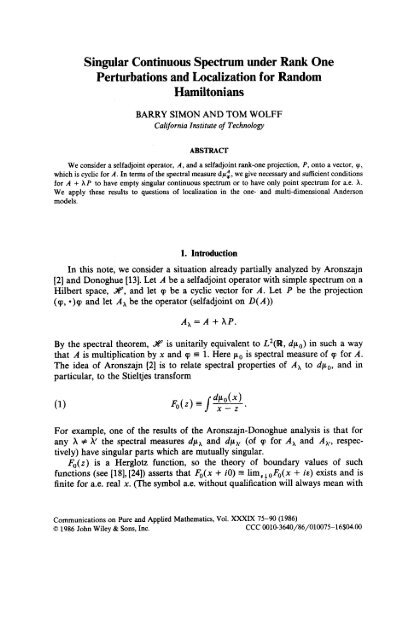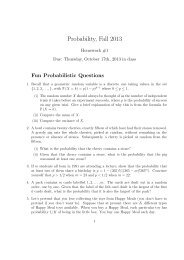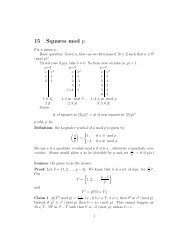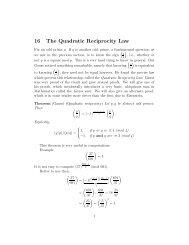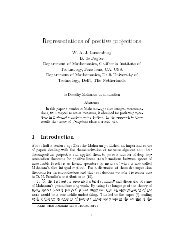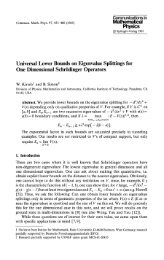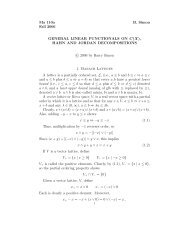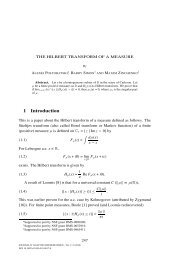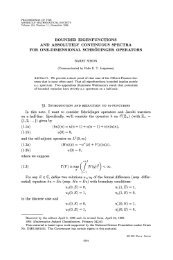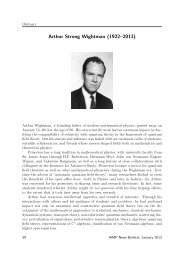Singular continuous spectrum under rank one perturbations and ...
Singular continuous spectrum under rank one perturbations and ...
Singular continuous spectrum under rank one perturbations and ...
You also want an ePaper? Increase the reach of your titles
YUMPU automatically turns print PDFs into web optimized ePapers that Google loves.
<strong>Singular</strong> Continuous Spectrum <strong>under</strong> Rank One<br />
Perturbations <strong>and</strong> Localization for R<strong>and</strong>om<br />
Hamiltonians<br />
BARRY SIMON AND TOM WOLFF<br />
California Institute of Technology<br />
ABSTRACT<br />
We consider a selfadjoint operator, A, <strong>and</strong> a selfadjoint <strong>rank</strong>-<strong>one</strong> projection, P, onto a vector, 9,<br />
which is cyclic for A. In terms of the spectral measure dp;, we give necessary <strong>and</strong> sufficient conditions<br />
for A + A P to have empty singular <strong>continuous</strong> <strong>spectrum</strong> or to have only point <strong>spectrum</strong> for a.e. A.<br />
We apply these results to questions of localization in the <strong>one</strong>- <strong>and</strong> multi-dimensional Anderson<br />
models.<br />
1. Introduction<br />
In this note, we consider a situation already partially analyzed by Aronszajn<br />
[2] <strong>and</strong> Donoghue [13]. Let A be a selfadjoint operator with simple <strong>spectrum</strong> on a<br />
Hilbert space, 2, <strong>and</strong> let cp be a cyclic vector for A. Let P be the projection<br />
(cp, -)cp <strong>and</strong> let A, be the operator (selfadjoint on D(A))<br />
A, = A + XP.<br />
By the spectral theorem, 2 is unitarily equivalent to L*(W, dpo) in such a way<br />
that A is multiplication by x <strong>and</strong> cp E 1. Here po is spectral measure of cp for A.<br />
The idea of Aronszajn [2] is to relate spectral properties of A, to dpo, <strong>and</strong> in<br />
particular, to the Stieltjes transform<br />
Fo(z) /u,<br />
x-z<br />
For example, <strong>one</strong> of the results of the Aronszajn-Donoghue analysis is that for<br />
any X # A’ the spectral measures dp, <strong>and</strong> dp,, (of cp for A, <strong>and</strong> A,,, respec-<br />
tively) have singular parts which are mutually singular.<br />
F,(z) is a Herglotz function, so the theory of boundary values of such<br />
functions (see [18], [24]) asserts that Fo(x + i0) = limeLoF0(x + i ~ exists ) <strong>and</strong> is<br />
finite for a.e. real x. (The symbol a.e. without qualification will always mean with<br />
Communications on Pure <strong>and</strong> Applied Mathematics, Vol. XXXIX 75-90 (1986)<br />
0 1986 John Wiley & Sons, Inc.<br />
CCC 0010-3640/86/010075-16$04.00
76<br />
B. SIMON AND T. WOLFF<br />
respect to Lebesgue measure.) We shall also need the function<br />
with the convention 00 -1 = 0. Then we shall prove<br />
THEOREM 1. The following are equivalent:<br />
(a) For a.e. A, A, has empty singular <strong>continuous</strong> <strong>spectrum</strong>.<br />
(b) For a.e. x, B(x) + YmFo(x + i0) > 0.<br />
Since B(x) <strong>and</strong> YmF,(x + i0) are both non-negative, statement (b) says that<br />
{xlB(x) > 0) U {xlYmFo(x + i0) > 0) has full measure. In fact, since<br />
these two sets are disjoint.<br />
We shall also prove<br />
THEOREM 2. The following are equivalent:<br />
(a) For a.e. A, A, has only point <strong>spectrum</strong>.<br />
(b) For a.e. x, B(x) > 0.<br />
While we started these theorems on all of R, they have local versions whose<br />
proofs are identical. For example:<br />
THEOREM 2'.<br />
Fix an open interval (a, b). The following are equivalent:<br />
(a) For a.e. A, A, has only point <strong>spectrum</strong> in (a, b).<br />
(b) For a.e. x in (a, b), B(x) > 0.<br />
These theorems will be a simple consequence of the ideas of Aronszajn-<br />
Donoghue <strong>and</strong> the fact (Theorem 5) that dq(x) = /(l + dp,(x) dA is<br />
mutually equivalent to Lebesgue measure. We discovered this later fact in trying<br />
to <strong>under</strong>st<strong>and</strong> some work of Kotani [19] on the effect of boundary conditions on<br />
certain classes of r<strong>and</strong>om Hamiltonians. The analogue of Theorem 5, due to<br />
Carmona [5], played a major role in Kotani's work. In fact, this part of our work<br />
in a sense bears the same relation to Carmona-Kotani as Donoghue's work bears<br />
to that of Aronszajn.<br />
While these two theorems are of some interest as abstract mathematics,<br />
their significance is increased by their connection to the theory of r<strong>and</strong>om<br />
Hamiltonians. In particular, we discuss the Anderson model here. One of us will<br />
discuss further applications elsewhere (see [20], [27]). The Anderson [l] model is
SINGULAR CONTINUOUS SPECTRUM-RANDOM HAMILTONIANS<br />
an ensemble of operators on l*(Z”),<br />
(44 H, = Ho+ V,,<br />
where H, is a fixed operator<br />
<strong>and</strong> V, is the r<strong>and</strong>om diagonal matrix<br />
<strong>and</strong> the V. (n) are independent, identically distributed real r<strong>and</strong>om variables with<br />
distribution BK(x). It is a consequence of the ergodic theorem that the <strong>spectrum</strong><br />
<strong>and</strong> spectral type is a.e. independent of w (see [21]). Spectral properties of these<br />
operators have evoked considerable interest in both the physical <strong>and</strong> mathemati-<br />
cal literature; see [6], [8], [29] for three recent reviews of the mathematical situa-<br />
tion.<br />
Under suitable conditions (v = 1,2 or when v 2 3, at energies near the edge<br />
of spec (H,) or when V is “very r<strong>and</strong>om”) it is believed that H, has only point<br />
<strong>spectrum</strong> dense in some regions; this has been proven in various circumstances<br />
(see below). This phenomenon is intimately related to the problem discussed in<br />
this paper. For, let A, = H, - V,(O)P, where P = (Ao, *)So is the projection<br />
onto the vector A, f 12(Zu). Then<br />
H, =A, + XP,<br />
where X is independent of A, <strong>and</strong> distributed according to the law dK. Thus, if<br />
dK is absolutely <strong>continuous</strong>, Theorem 2 says that a sufficient condition for H, to<br />
have only point <strong>spectrum</strong> for a.e. w is that B,(E) > 0 for a.e. E (actually, we do<br />
not know that 6, is cyclic for A,, so B,(E) > 0 only implies that the spectral<br />
measure dpZo is pure point-<strong>one</strong> then needs an additional argument; see Sections<br />
5 <strong>and</strong> 6). And if dK has essential support (- 00, 00), then B,( E ) > 0 for a.e. E is<br />
also necessary for H, to only have point <strong>spectrum</strong>.<br />
Thus, Theorem 2 will allow a new proof of localization in the Anderson<br />
model. For v = 1, we recover the result of Kunz-Souillard [21] <strong>and</strong> Delyon et al.<br />
[ll]. Our proof is, we believe, more elementary than that in [ll], [21] <strong>and</strong> requires<br />
much weaker hypotheses on BK. It will even extend to fairly general situations<br />
where V is no longer independent at distinct sites (see [20], [27]). Nevertheless, the<br />
translation invariance plays an important role in our proof but not in [ll]. We<br />
emphasize that the method of Delyon et al. [ll] can treat H, + V, + W for<br />
arbitrary fixed W (see [ll]) <strong>and</strong> also the case of decaying r<strong>and</strong>omness (see<br />
[26], [12], [lo]), <strong>and</strong> we do not see how to discuss those cases with the method of<br />
this paper (the defect is not in Theorem 2, but in Furstenberg’s theorem!). Our<br />
77
78 B. SIMON AND T. WOLFF<br />
discussion of the v = 1 case is closely related to a recent proof of Kotani [19]<br />
obtained independently of our work (we were motivated by a preliminary version<br />
of [19] which did not contain this result).<br />
For v > 1, we recover recent results of Frohlich et al. [15] <strong>and</strong> Goldsheid [16].<br />
Since the appearance of our work is roughly simultaneous with theirs, we wish to<br />
emphasize that their work preceded ours by some months.<br />
In Section 2, we prove Theorems 1 <strong>and</strong> 2. In Section 3, we present some<br />
simple examples that show that the results really do hold only for a.e. X <strong>and</strong> not<br />
all A. In Section 4, we express the condition B(E) > 0 in terms of the Green's<br />
function for A, i.e., matrix elements of the resolvent (&,,,(A - E + i~)-l&,). In<br />
Section 5, we use Section 4 <strong>and</strong> work of Ishii [17] or Deift-Simon [9] to get<br />
localization in dimension 1. In Section 6, we use Section 4 <strong>and</strong> work of<br />
Frohlich-Spencer [14] to get localization in dimension v > 1. Finally, in Section 7,<br />
we discuss the connection of our work with that of Kotani [19]. In particular, we<br />
prove localization in v > 1 dimension using only Theorem 5 <strong>and</strong> not Theorem 2<br />
by exploiting Kotani's philosophy <strong>and</strong> ideas of Martinelli-Scoppola [22].<br />
An announcement of our results appears in [28].<br />
While we were proofreading the typescript of this manuscript, we received a<br />
paper from Delyon, Levy <strong>and</strong> Souillard [30] (with related works [31],[32] in<br />
preparation) related to our work here. Also motivated by Kotani, they prove<br />
localization in the multi-dimensional Anderson model from estimates of<br />
Frohlich-Spencer [14]. Their proof is very close to the <strong>one</strong> we give in Section 7,<br />
the main difference being that in place of our abstract Theorem 5, they use an<br />
eigenvalue perturbation theory argument with roots in [21], [33].<br />
We should like to thank S. Kotani for telling us of his work, <strong>and</strong> L. Arnold<br />
<strong>and</strong> W. Wischutz for organizing a conference which allowed <strong>one</strong> of us (B.S.) to<br />
learn of Kotani's work.<br />
2. Proof of the Main Theorems<br />
It is fairly easy to see that cp is cyclic for A,, so to study the spectral<br />
properties of A, we need only study the spectral measure dp, of cp for A,. One<br />
key element of the proof is the following result of Aronszajn [2]. We say that a<br />
measure q is supported on A if q(W \A) = 0. ptc; pic; pf.P. denote the ab-<br />
solutely <strong>continuous</strong>, singular <strong>continuous</strong> <strong>and</strong> pure point parts of p,.<br />
THEOREM 3 (Aronszajn [2]). Let X = {xl#mF,(x + i0) > 0}, Y = {xlB(x)<br />
> 0}, Z = W \ ( X U Y). Then, for any X # 0, pic. is supported on X, pi.P. is<br />
supported on Y, <strong>and</strong> pic. is supported on Z.<br />
Because we need some of the lemmas later <strong>and</strong> for the reader's convenience,<br />
we sketch the proof of this result. By definition of dp,,
SINGULAR CONTINUOUS SPECTRUM-RANDOM HAMILTONIANS<br />
Taking expectation values of the second resolvent equation<br />
yielding Aronszajn’s [2] fundamental relation:<br />
(5b) FA(z) = F O(z)/(l + x FO(z))*<br />
From this, we first deduce the following variant of a result of Aronszajn [2].<br />
THEOREM 4. Fix X # 0. Then dpA has a pure point at xo E R if <strong>and</strong> on@ if<br />
Moreouer, X-2B(x,) is precisely the pA measure of { xo}.<br />
Proof: Since<br />
the dominated convergence theorem implies that<br />
pA((x0)) = l i m ~ ~ m ie), ~ ~ ( ~ ~ +<br />
lime9~FA(xo + ie) = 0.<br />
€10<br />
e10<br />
Therefore, if pA({x0}) # 0, then FA(x0 + ie) + a0 which, by (5b), implies that<br />
F,(x, + i E) -X-’.<br />
79
80 B. SIMON AND T. WOLFF<br />
so<br />
(8)<br />
Moreover, by the monot<strong>one</strong> convergence theorem, we always have<br />
If (a) holds, then (6) implies that<br />
But, by (51,<br />
limFo/EFA = ~-'i[p~({x~})]-',<br />
EL0<br />
lim ~m [ I ;~/EF~ 1 = A- 'pA( { xo 1 ) - '.<br />
&LO<br />
(9) Ym[FO/EFA] = &-'Ym(l + A&) = &-'h..%Fo.<br />
Relations (7)-(9) show that if (a) holds, then A2pX({~,,)) = B(xo). Thus (a)<br />
<strong>and</strong> (b) imply that dph has a pure point at xo, <strong>and</strong> conversely, if dpA has an<br />
atom, we conclude first that (a) holds <strong>and</strong> then that (b) holds.<br />
To complete the proof of Theorem 3, we need several facts:<br />
(i) dptc.= T-'Y~F~(x + i0) dx,<br />
(ii) dptc. is supported on { xllimYmFA(x + iE) = m),<br />
(iii) B(x) > 0 implies that limeloF,(x + ie) exists <strong>and</strong> is real.<br />
i) is a st<strong>and</strong>ard fact in the theory of Steiltjes transforms see [MI, [24]). ii) is a<br />
weak form of the theorem of de Vallee Poussin [24] which gives the result with lim<br />
replaced by lim); we state it in this form, since this is easier to prove than the full<br />
theorem <strong>and</strong> suffices. iii) is a simple consequence of the dominated convergence<br />
theorem.<br />
Proof of Theorem 3: By Theorem 4, pfp. is supported on Y.<br />
By ii) <strong>and</strong> iii), dpr is supported on<br />
{XIB(X) = 0} u {xl~(x) > 0, F,(X + iO) = -A-'}.<br />
By Theorem 4, the second set is precisely the set of point masses for p A <strong>and</strong> thus<br />
countable. Countable sets have ps'c' zero measure so we see that pr is supported<br />
on {xlB(x) = O}. If &YmFA(x + ie) = m, then by (5), there must be a<br />
sequence E , with Fo(x + ie,) -+ -A-' which is inconsistent with YmF,(x + i0)<br />
> 0. Thus py is supported on the complement of X; i.e., we have shown that p y<br />
is supported on (R \ X ) n (W \ Y ) = R \ ( X u Y).<br />
Finally, w H w/l + Ao is a transformation mapping { z)Ymz > 0} into itself<br />
with the inverse doing the same thing. Thus<br />
{xlYmFdA(x + i0) > 0} = { x(YmFo(x + iO)} = X.<br />
By (i), we conclude that X supports dpy.
SINGULAR CONTINUOUS SPECTRUM-RANDOM HAMILTONIANS 81<br />
The next result is an abstract analogue of a formula implicit in Carmona [5]<br />
<strong>and</strong> explicit in Kotani [19]. Since p,, is a probability measure for each h (if cp is<br />
normalized), we can define a measure q by<br />
for any set A.<br />
THEOREM 5. is mutually equivalent to Lebesgue measure.<br />
Proof: Since Ix - z1-l I1mzl-l for any real x, we see that when<br />
$mz > 0,<br />
Since an elementary contour integration shows that, for any w with $mu > 0,<br />
we conclude by (5) that<br />
Since $mFo > 0 in the upper half-plane, IH(z)l 5 K <strong>and</strong> so 3mH(z) 5 K.<br />
From this <strong>and</strong> the fact that K-'AZH(X + ie)dx converges weakly to dq, it<br />
follows that<br />
dqs dx<br />
so that dq is absolutely <strong>continuous</strong> with respect to Lebesgue measure. On the<br />
other h<strong>and</strong>, taking the limit e J.0 for xo + ie in (ll), we see that<br />
{ x ~ A w ~ + ( iO) x = O } = {xlFo(x + io) = O }.<br />
By general principles on the boundary values of analytic functions (see [18]), this<br />
last set has Lebesgue measure zero. Thus<br />
dq(x) = K-'AZH(X + i0) dx<br />
is equivalent to Lebesgue measure. This result provides the essential link between<br />
sets of zero Lebesgue measure <strong>and</strong> sets of zero spectral measure, as follows.<br />
Proof of Theorem 1: By Theorem 3, py(W) = px(R \ (X U Y)). Thus A,<br />
has empty singular <strong>continuous</strong> <strong>spectrum</strong> for a.e. X if <strong>and</strong> only if pA(R \ (X u Y))
82 B. SIMON AND T. WOLFF<br />
is zero for a.e. A. This happens if <strong>and</strong> only if<br />
ldA(1 + A2)-1pA(R \(XU Y)) = 0.<br />
By Theorem 5, this holds if <strong>and</strong> only if R \ (X U Y ) has Lebesgue measure zero,<br />
or equivalently if a.e. x E X U Y.<br />
Proof of Theorem 2: By Theorem 3, py(R) + p;'.(R) = px(R \ Y). Now,<br />
we argue as above.<br />
3. Some Examples<br />
Notice that a measure dp,, determines both the operator A <strong>and</strong> the vector<br />
q = 1, <strong>and</strong> so the entire example.<br />
EXAMPLE 1. Let po be the conventional Cantor measure. Any x E C has a<br />
base three expansion with only zeros <strong>and</strong> twos. For each n, { yly E C <strong>and</strong> y <strong>and</strong><br />
x agree in their expansions for the first n digits} are a distance at most 3-" from<br />
x. Thus p{y E C( )x - yJ 5 3-"} 2 2-" <strong>and</strong> so /dp(y)/lx - yla = co if a 2<br />
log2/log3. In particular, B(x) = 0 on C. Thus, by Theorem 4, A, has eigenvalues<br />
only in the gaps of C. Since IF(x + iO)( --j 00 at edges of gaps, there is<br />
exactly <strong>one</strong> in each internal gap (for there is <strong>one</strong> solution of Fo(x + i0) = -A-'<br />
in each gap). Theorem 1 implies that for a.e. A, dpA has no singular <strong>continuous</strong><br />
part. Actually, <strong>one</strong> can say more: if x E C, then<br />
,amF,(x + i3-") 2 $3"p{ y E C( Ix - y( 5 3-"} + 0O,<br />
so J~z FA stays away from infinity. Thus, dpA,,ing is supported off C = ueess(AA),<br />
i.e., dpx,,.,,= 0. To summarize: If p is the Cantor measure, for each A # 0, pA<br />
has only pure point <strong>spectrum</strong>; all eigenvalues are discrete, but the closure of the<br />
eigenvalues consists of all of C. pA has thick point <strong>spectrum</strong> in the sense of [3].<br />
Take 2 = A + P; we see that A + AP has singular <strong>continuous</strong> <strong>spectrum</strong> for<br />
exactly <strong>one</strong> value of A. For the A problem, Theorem 2 holds, but the conclusion<br />
is not for all A.<br />
EXAMPLE 2. Let 6, be the unit mass at x. Let p = Can dp, with<br />
Obviously we require E a,, < 00. If 0 x 5 1, (i.e. x E spec(A)), there is some j<br />
2"
SINGULAR CONTINUOUS SPECTRUM-RANDOM HAMILTONIANS<br />
with Ix -j/2,l 5 2-" so<br />
/Ix -yl-2dpn(y) 1 ( 2-y-" = 2"<br />
It follows that if C 2"u, = 00, then B(x)-' = 03 on [0,1], so by Theorem 4, pLx<br />
has no pure points on [0,1]. Moreover, since { x(YmF,(x + i0)) has measure<br />
zero, dptc.= 0 for all A. Thus dp,, has support [0,1]. There is <strong>one</strong> eigenvalue on<br />
R \[O, 11. To summarize, if Xu, < 00, C2%, = 00, then, when A # 0, p, has<br />
(except for <strong>one</strong> simple eigenvalue) only singular <strong>continuous</strong> <strong>spectrum</strong> [0,1].<br />
These two examples, closely related to examples in Aronszajn [2], present a<br />
striking contrast: A purely S.C. measure turning into pure point <strong>spectrum</strong> for all<br />
values of A <strong>and</strong> a pure point <strong>spectrum</strong> turning into (essentially) purely S.C.<br />
<strong>spectrum</strong> for all A.<br />
EXAMPLE 3. Let x, be arbitrary points. Let 0 5 a, 5 Can with a < 1 <strong>and</strong><br />
let dpo(x) = C a,, dxn. We claim that B(x) > 0 a.e. This follows from:<br />
Thus<br />
PROPOSITION 6. If 0 < a < 1, then for ae. x,<br />
H(x) = C aqx - x,1-2 < O3,<br />
n<br />
Proof: If 1x - x,1 > C-1/2a"/4, then<br />
goes to zero as C -, 00.<br />
H(x) < CCa"/2 = c(1 - a lly.<br />
n<br />
Thus, in this case, A, continues to have only pure point <strong>spectrum</strong> for a.e. A.<br />
Notice that if A, has eigenvalues at the points j/Zn, 0 < j 5 2", n = + 1,2; *,<br />
then distinct choices of cp correspond to distinct choices of weights a, in<br />
dpo(x) = C u,Sxn. We can pick cp to yield either Example 2 or 3. This shows that,<br />
in general, different <strong>rank</strong>-<strong>one</strong> <strong>perturbations</strong> can yield dramatically different<br />
spectral consequences.<br />
EXAMPLE<br />
4. Let dp, = dpc + dx [0,1], where dx is Lebesgue measure <strong>and</strong><br />
dpc Cantor measure. Then YmF(x + i0) = 1 on (0,l) so A, has only a.c.<br />
<strong>spectrum</strong> on [0,1] <strong>and</strong> <strong>one</strong> eigenvalue in W \ [0,1]. The point of this example is<br />
that if dv, = dp,,, then dv-,, = dp, has a singular <strong>continuous</strong> part. Thus, while<br />
83
84 B. SIMON AND T. WOLFF<br />
AvzF~,(x + i0) > 0 for a.e. x in [0, I], it can happen that Ap) has singular<br />
<strong>continuous</strong> <strong>spectrum</strong> for some X (although by Theorem 1 the set must have<br />
measure zero).<br />
4. A Criterion for Dense Point Spectrum in the Anderson Model<br />
We begin by writing an operator theoretic formula for B(x). Let cp = rpo <strong>and</strong><br />
let { rpn }, E, be an orthonormal basis labeled by some index set I including cpo.<br />
Let<br />
Then we have<br />
G(n, m; Z) (Tn,(A - z)-lcpm).<br />
PROPOSITION 7. For x E R,<br />
1. - yIp2 dpo(y) = lim<br />
'$0 nGI<br />
(G(n,O; x + ie)I2.<br />
Proof: Clearly, by the monot<strong>one</strong> convergence theorem,<br />
Remark. As we have already noted, B(x) > 0 supplies a <strong>one</strong> line proof (see<br />
equation (3)) that 9mFo(x + i0) = 0 <strong>and</strong> so #mFh(x + i0) = 0 for all A. Thus<br />
the control of the Green's function in higher dimension by Frohlich-Spencer [14]<br />
(see Section 6) immediately implies that dpkc.(x) = K-'~&ZF,(X + i0) dx = 0,<br />
providing a quick proof that dp"". = 0 in that case. This gives a brief alternate to<br />
an argument of Martinelli-Scoppola [22].<br />
For the remainder of this section, we specialize to discuss the Anderson model<br />
given by equation (4). We suppose dK obeys /(log+lxl) dK < 00.<br />
THEOREM 8. Consider the two statements for the v-dimensional Anderson<br />
model:<br />
(a) For a.e. w, H, has on& point <strong>spectrum</strong> in (a, b).<br />
(b) For a.e. E E (a, b) <strong>and</strong> a.e. (w),
Then,<br />
SINGULAR CONTINUOUS SPECTRUM-RANDOM HAMILTONIANS 85<br />
(i) if du is purely a.c., (b) implies (a),<br />
(ii) if v = 1 <strong>and</strong> dK has a nonzero a.c. comp<strong>one</strong>nt, then (b) implies (a),<br />
(iii) if the a.c. comp<strong>one</strong>nt of dK has essential support (- 00,oo) (e.g. dK is<br />
Gaussian), then (a) implies (b).<br />
Proof Theorems 1 <strong>and</strong> 2 are only stated for the cyclic case. They im-<br />
mediately apply to a general A + XP (with P of <strong>rank</strong> 1) to the cyclic subspace<br />
generated by A <strong>and</strong> Ran P, <strong>and</strong> so they say something about the spectral measure<br />
dpx associated to cp E Ran P.<br />
If we fix w but then vary V(0) to a new value v(0) holding { V( n)}, + fixed,<br />
we obtain the operators A + XP with A = H,, X = v(0) - V,(O), P = (So, *)ao.<br />
Thus Theorem 2 <strong>and</strong> Proposition 7 say that d&, is pure point for a.e. w, A if<br />
<strong>and</strong> only if (12) holds for a.e. E, w. But by the independence of V,(O), dp?.<br />
with w distributed by the i.i.d. process <strong>and</strong> X by dK(* - V,(O)) is precisely dpt.<br />
Thus (iii) is immediate <strong>and</strong> (b) implies that dp? has only pure point <strong>spectrum</strong> for<br />
a.e. choice of { V(n)},,o <strong>and</strong> a.e. choice of V(0) from the absolutely <strong>continuous</strong><br />
comp<strong>one</strong>nt of dK. Under hypothesis (i), this implies that dp? is pure point for<br />
a.e. w. By translation invariance, this is true for each dp$ so H, has only pure<br />
point <strong>spectrum</strong>.<br />
In case (ii), with positive probability V(0) <strong>and</strong> V(1) both lie in their absolutely<br />
<strong>continuous</strong> comp<strong>one</strong>nts. Thus, with positive probability, both dp? <strong>and</strong> dp? are<br />
pure point in (a, b). Since So, S, are cyclic for H,, H, has only pure point<br />
<strong>spectrum</strong> in (a, b) with positive probability. But the spectral type of H, is a.e.<br />
constant (see [21]), so the positive probability result implies the result for a.e. w.<br />
One can also deduce exp<strong>one</strong>ntial decay of eigenfunctions from exp<strong>one</strong>ntial<br />
decay of G:<br />
THEOREM 9. Suppose that dK is purely absolutely <strong>continuous</strong>, <strong>and</strong> that, for a.e.<br />
pairs (a, E ) (w E Q, the probability space for V(,) <strong>and</strong> E E (a, b) with Lebesgue<br />
measure), we have that for 0 < E < 1<br />
Then, with probability 1, the eigenfunctions cpg) with E E (a, b) obey<br />
Proof: Taking matrix elements of (5a) for the pair (a, *So) we see that (with<br />
A, = H(") + AS,)<br />
(S,,(AA - z)-'So) = G(n,O; z)(l - XF,(z)).
86 B. SIMON AND T. WOLFF<br />
If E is an eigenvalue of A,,<br />
Since (13) implies (12), arguments similar to Theorem 8, using Theorem 5, show<br />
that, for a.e. pair (w, A), H" + ASo has eigenfunctions obeying (14). But since dK<br />
is purely a.c., this implies the result for a.e. H".<br />
THEOREM 10.<br />
5. Localization in the One-Dimensional Anderson Model<br />
(a) dK has an a.c. comp<strong>one</strong>nt,<br />
(b) I(log+lxl) dK(X) < 00,<br />
has onZy pure point <strong>spectrum</strong>.<br />
The Y = 1 model with an arbitrary dK obeying<br />
Proof: By Theorem 8, we need only prove (12). By (b), y(E) exists, <strong>and</strong> by<br />
Furstenberg's theorem it is positive for all E. Thus, by Theorem 6.5 of Deift-Simon<br />
[9], for a.e. (a, E), jdp+(E', w)/(E' - E)2 < 00 or E is an eigenvalue of H,'.<br />
Here H,' is the half-line operator with u(0) = 0 boundary conditions <strong>and</strong> dp+ is<br />
the associated spectral measure for 6,. But the set of eigenvalues of H,' is<br />
countable, so, for a.e. (a, E), jdp+(E', w)/(E' - E)2 = S+(w, E) < 60, a similar<br />
equation holding for S-(o, E). In terms of the m * functions of [25], [9],<br />
S+(w, - E) = lim,,oe-lYmm,(o, E + iE) <strong>and</strong><br />
where dp" is the spectral measure for So <strong>and</strong> the operator Ha on all of Z. Since<br />
m++ m-+ e - V"(0) is a Herglotz function on the upper half-plane for each w,<br />
for a.e. pair (w, E).<br />
Ym(m+(w, E + i0) + m-(o, E + i0) + E - Vu(0)) = q(o, E)<br />
is non-zero (see [ls]). Thus<br />
is a.e. finite <strong>and</strong> (12) holds.<br />
Remarks 1. Ishli [17] has an argument which directly controls the Green's<br />
function <strong>and</strong> proves that (12) holds directly. His argument, while stated for
SINGULAR CONTINUOUS SPECTRUM-RANDOM HAMILTONIANS 87<br />
bounded V <strong>and</strong> the half-line, can be seen to only require jdK(x)(log+((x()'+8 <<br />
00, <strong>and</strong> to hold on the whole line.<br />
2. A more direct proof of (12) exploiting the Osceledec theorem <strong>and</strong> Theorem<br />
4 will be given in [27]. This applies also to the strip. Nonindependent V,(n)<br />
will also be discussed.<br />
3. By the Osceledec theorem, <strong>one</strong> proves that eigenfunctions decay at the<br />
Lyaponov exp<strong>one</strong>nt rate, recovering a result of Carmona [4] <strong>and</strong> Craig-Simon [7].<br />
6. Localization in the Multi-Dimensional Anderson Model<br />
Several years ago, Frohlich-Spencer [14] proved the following theorem:<br />
THEOREM 11.<br />
Fix P. Let v be general, <strong>and</strong> suppose that either:<br />
(a) dK is absolutely <strong>continuous</strong> with IldK/dEll, suficiently small <strong>and</strong> E is<br />
arbitrary, or<br />
(b) dK is Gaussian <strong>and</strong> IEl is large.<br />
Then, for constants C <strong>and</strong> m depending on@ on IldK/dEll, (or E) <strong>and</strong> p, <strong>one</strong><br />
has<br />
with probability at least 1 - CN-P. Moreover, as IldK/dEll, or E-I goes to zero,<br />
m goes to injnity.<br />
Since the set of w where (15) holds is increasing with N <strong>and</strong> the measure goes<br />
to zero, we see that, for a.e. w,<br />
sup IG,,,(On; E + ie)] 6 Ce-"l"l<br />
O
88 B. SIMON AND T. WOLFF<br />
analysis:<br />
1. An argument that any singular <strong>continuous</strong> <strong>spectrum</strong> must lie in a set of<br />
Lebesgue measure zero of energy, a priori given by the potential outside some<br />
finite region A.<br />
2. A proof that, for most choices of the potential inside A, any particular set<br />
of Lebesgue measure zero will have zero spectral measure.<br />
From this point of view, the verification that B(E) > 0 <strong>and</strong> Theorem 3<br />
provide step 1, while Theorem 5 is the key to step 2. Thus, <strong>one</strong> <strong>under</strong>st<strong>and</strong>s the<br />
relation of this argument to the work of Kotani [19], which motivated parts of it.<br />
The two-step philosophy is implicit in Kotani, who uses ideas of Pastur [23] for<br />
step 1. Step 2 in his study of boundary condition variation is the argument of<br />
Carmona; in the Anderson model case, he uses an argument less general than<br />
Theorem 5.<br />
One can obtain a partially alternate proof of Theorem 11 by using the analysis<br />
of Martinelli-Scoppola [22] for step 1. As in our argument, <strong>one</strong> uses Theorem 5<br />
for step 2. Explicitly, following [22], <strong>one</strong> can use the Borel-Cantelli lemma <strong>and</strong> the<br />
estimates of Frohlich-Spencer [14] to prove the following: Let GJx, y; E, w ) be<br />
the resolvent of the finite matrix H, , obtained by restricting H, to a box A,<br />
centered at 0 of side I," + 60 (I, = 2"72). Then, for each E <strong>and</strong> a.e. w, there is an<br />
no( w) such that<br />
(16)<br />
sup G,(x, y; E + ie, u) e-mlx-J"<br />
0
SINGULAR CONTINUOUS SPECTRUM-RANDOM HAMILTONIANS 89<br />
Essentially, we have made a very slight generalization of the Martinelli-<br />
Scoppola argument to show that for a.e. pairs (E, w ) any polynomially bounded<br />
solution of (17) decays exp<strong>one</strong>ntially. Given the philosophy <strong>and</strong> Theorem 5, <strong>one</strong><br />
obtains the promised alternative proof of Theorem 11.<br />
Acknowledgment. The research of the first author was partially supported by<br />
USNSF <strong>under</strong> Grants MCS-81-20833 <strong>and</strong> that of the second by DMS-84-07099.<br />
Bibliography<br />
Anderson, P. W., Absence of diffiion in certain r<strong>and</strong>om lattices, Phys. Rev. 109, 1958, p. 1492.<br />
Aronszajn, N., On a problem of Weyl in the theory of singular Sturm-Liouville equations, Am. J.<br />
Math. 79, 1957, pp. 597-610.<br />
Avron, J., <strong>and</strong> Simon, B., Transient <strong>and</strong> recurrent <strong>spectrum</strong>, J. Func. Anal. 43, 1981, pp. 1-31.<br />
Carmona, R., Exp<strong>one</strong>ntial localization in <strong>one</strong>-dimensional disordered systems, Duke Math. J. 49,<br />
1982, p. 191.<br />
Carmona, R., One-dimensional Schriidinger operators with r<strong>and</strong>om or deterministic potentials: New<br />
spectral types, J. Func. Anal. 51, 1983, pp. 229-258.<br />
Carmona, R., Lectures on R<strong>and</strong>om Schrijdinger Operators, 14th St. Flour Prob. Summer School<br />
Lectures.<br />
Craig, W., <strong>and</strong> Simon, B., Subharmoniciiy of the Lyaponov index, Duke Math. J. 50, 1983, pp.<br />
551-560.<br />
Cycon, H., Froese, R., Kirsch, W., <strong>and</strong> Simon, B., Topics in the Theory of Schriidinger Operators,<br />
Springer, to appear.<br />
Deift, P., <strong>and</strong> Simon, B., Almost periodic Schrijdinger operators, 111. The absolutely <strong>continuous</strong><br />
<strong>spectrum</strong> in <strong>one</strong> dimension, Comm. Math. Phys. 90,1983, pp. 389-411.<br />
Delyon, F., Apparition of purely singular <strong>continuous</strong> <strong>spectrum</strong> in a class of r<strong>and</strong>om Schrijdinger<br />
operators J. Stat. Phys., to appear.<br />
Delyon, F., Kunz, H., <strong>and</strong> Souillard, B., One-dimensional wave equations in disordered media, J.<br />
Phys. A16, 1983, p. 25.<br />
Delyon, F., Simon, B., <strong>and</strong> Souillard, B., From power pure point to <strong>continuous</strong> <strong>spectrum</strong> in<br />
disordered systems, Ann. Inst. H. Poincare, 42, 1985, p. 283.<br />
[13] Donoghue, W., On the perturbation of spectra, Comm. Pure Appl. Math. Vol. 18, 1965, pp.<br />
559-579.<br />
[14] Fr6hlich, J., <strong>and</strong> Spencer, T., Absence of diffusion in the Anderson tight binding model for large<br />
disorder or low energy, Comm. Math. Phys. 88,1983, pp. 151-189.<br />
[15] Frohlich, I., Martinelli, F., Scoppola, E., <strong>and</strong> Spencer, T., Anderson localization for large disorder<br />
or low energy, Rome, preprint.<br />
[16] Goldsheid, I., Talk at Tashkent Conference on Information Theory, Sept., 1984.<br />
[17] Ishii, K., Localization of eigenstates <strong>and</strong> transport phenomena in <strong>one</strong>-dimensional disordered<br />
systems, Supp. Prog. Theor. Phys. 53,1973, pp. 77.<br />
1181 Katznelson, Y., An Introduction to Harmonic Analysis, Dover, 1976.<br />
[19] Kotani, S., Lyaponov exp<strong>one</strong>nts <strong>and</strong> spectra for <strong>one</strong>-dimensional r<strong>and</strong>om Schrijdinger operators, to<br />
appear in Proc. 1984 AMS Conference on “R<strong>and</strong>om Matrices <strong>and</strong> their Applications”; Lyaponov<br />
exp<strong>one</strong>nts <strong>and</strong> point <strong>spectrum</strong> for <strong>one</strong>-dimensional r<strong>and</strong>om Schrijdinger operators, in prepara-<br />
tion.<br />
[20] Kotani, S., <strong>and</strong> Simon, B., Localization in general <strong>one</strong>-dimensional r<strong>and</strong>om systems, II. Continuum<br />
Schriidinger operators, in preparation.<br />
[21] Kunz, H., <strong>and</strong> Souillard, B., Sw le spectre des operatars aux diJTerencesfinies aleatoires, Comm.<br />
Math. Phys. 78,1980, pp. 201-246.
90 B. SIMON AND T. WOLFF<br />
[22] Martinelli, F., <strong>and</strong> Scoppola, E., A remark on the absence of absolutely <strong>continuous</strong> <strong>spectrum</strong> in the<br />
Anderson model for large disorder or low energy, Comm. Math. Phys., 97, 1985, p. 465.<br />
[23] Pastur, L., Spectral properties of disordered systems in <strong>one</strong>-body approximation, Comm. Math.<br />
Phys. 75, 1980, p. 179.<br />
[24] Saks, S., Theory of the Integral, G. E. Stechert, New York, 1937.<br />
[25] Simon, B., Kotani theory for <strong>one</strong>-dimensional stochastic Jacobi matrices, Comm. Math. Phys. 89,<br />
1983, p. 227.<br />
[26] Simon, B., Some Jacobi matrices with decayingpotential <strong>and</strong> dense point <strong>spectrum</strong>, Comm. Math.<br />
Phys. 87, 1982, pp. 253-258.<br />
[27] Simon, B., Localization in general <strong>one</strong>-dimensional r<strong>and</strong>om system, I. Jacobi matrices, Comm.<br />
Math. Phys., to appear.<br />
[28] Simon, B., Taylor, M., <strong>and</strong> Wolff, T., Some rigorous results for the Anderson model, submitted to<br />
Phys. Rev. Lett.<br />
[29] Spencer, T., The Schrijdinger equation with a r<strong>and</strong>om potential, a mathematical reuiew; to appear<br />
in Proc., 1984, Les Houches Summer School.<br />
[30] Delyon, F., Levy, Y., <strong>and</strong> Souillard, B., Anderson locaiization for multi-dimensionai systems at<br />
large disorder or large energy, Comm. Math. Phys., to appear.<br />
[31] Delyon, F., Levy, Y., <strong>and</strong> Souillard, B., Anderson localization for <strong>one</strong> <strong>and</strong> quasi <strong>one</strong>-dimensional<br />
systems, in preparation.<br />
[32] Delyon, F., Levy, Y., <strong>and</strong> Souillard, B., An approach “a la Borl<strong>and</strong>” to Anderson localization in<br />
multi-dimensional disordered systems, Phys. Rev. Lett, 55, 1985, p. 618.<br />
[33] Wegner, F., Bounded on the density of states of disordered systems, Z. Phys. B44, 1981, pp. 9-15.<br />
Received March, 1985


